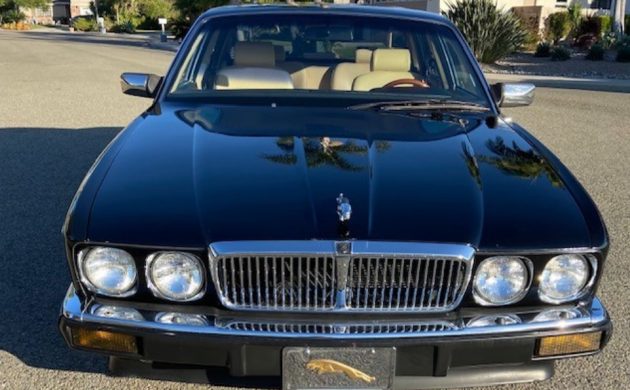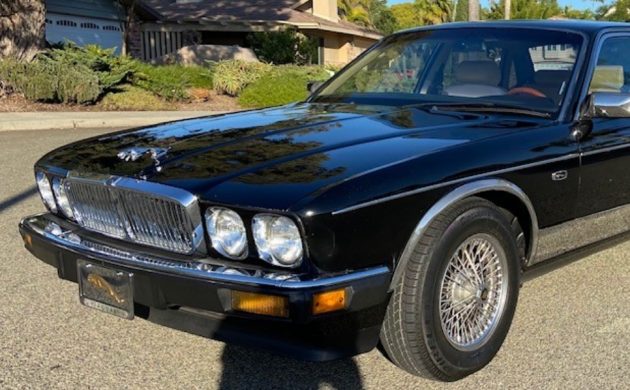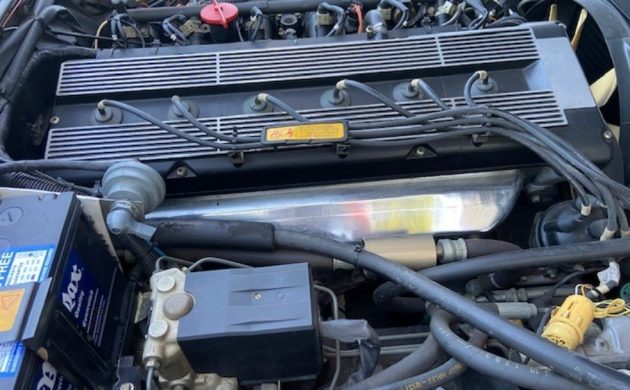The Jaguar XJ was a series of full-size luxury cars produced by the British automobile manufacturer from 1968-2019. Beginning in 1970, it would be Jaguar’s flagship 4-door model. For several years, you could order the Vanden Plas edition of the XJ, which featured a much higher level of trim and conveniences. That includes the seller’s 1988 model, with just 50,000 miles on the odometer it looks like a true survivor in beautiful overall condition. Located in Carlsbad, California, this XJ-6 is available here on Barn Finds Classifieds for $9,800.
Series III versions of the car were built between 1979-92. Subtle exterior styling changes were executed by designer Pininfarina. Depending on the model, both six-cylinder and V12 models were offered that incorporated Bosch fuel injection. The V12 would not be offered in the U.S. after 1980. Over its long run, some 318,000 of the XJ cars were built, of which 133,000 were Series III. The seller’s car has Jaguar’s 3.6-liter inline-6.
If the XJ wasn’t fancy enough in its own right, you could order one that was decked out by Vanden Plas, a group of coachbuilders who produced upgrades for European luxury car makers like Jaguar. These cars were available from the 1980s and through 2009. From what I can tell, the Vanden Plas copies were akin to what you’d have if you crossed a Jaguar with a Rolls-Royce. This 1988 model is a one-family car since it was purchased new in Southern California and has been babied for most of its existence.
This car has some interesting extras, such as a handheld Technophone (!) and bolt-on chrome wire wheels that were added by the dealer. The body and paint (what we see of it) look good and the interior appears as nice as it was in 1988. The leather is nice and the dash pad has nary a crack. The seller can provide a copy of the car’s CARFAX report which will back up the mileage and crash-free claims. Not everything is functional after 33 years, such as the phone and electric antenna. We assume the latter can be addressed by a dealer but why bother with the car phone in this wireless age we live in!






I’m wondering was this the time period when Ford owned Jaguar?
It is a pre-Ford Jag.
1994
Jags of the 80’s were plagued with electrical gremlins.
I did bodywork on these around 1993-1994 at a Ford processing center near the Baltimore Harbor. Very nice bodywork and interiors but they would be roached in a few years. These don’t bring much.
I’ve owned several Jags of this era. As a rule of thumb, stay away from the 3.6 cars and go for the 4.0 single headlight version. The issue is build quality and early production gremlins.
There’s a lot wrong with this posting. Xj-6 Series III ended in 1987, this would be the Xj-6 XJ40 variant which came out in 1988. Very different car, lot less parts, probably the better car – I have owned both. Having the one gas tank in the XJ40 was a huge plus versus the leaking mess of the Series 1-3 with dual tanks.
The author says Series III production continued through 1992, which is correct. You say XJ-6 Series III production ended in 1987, which is also correct. It’s the XJ-12 Series III that continued through 1992.
Nothing like trying to sell a car and not showing the side and back with the pictures
She is a beauty.
I had a 1974 version which I put in a TPI 350 and R4-700 trans. The car ran great, it handles well. But the factory breaks just were not enough to stop the, way more than Jaguar mills, TBI’s acceleration abilities. Still looked good, but was freaky fast for a Gentleman’s Jag.
The phone likely doesn’t work because it’s obsolete, not nonfunctional.
@grant – correct it would be an analog phone. I had a 91 XJS and it had a removable Jaguar branded Motorola StarTAC flip phone in the console.
The author really needs to do proper research before publishing information. Yes, the Series III was built from 1979 through 1992, BUT this is NOT a Series III. It is a XJ40 released by Jaguar Cars Ltd independent of British Leyland / Austin Rover but prior to the Ford / GM bidding war where Ford was the highest bidder….I hesitate to say “winner” because the big automakers were on a shopping spree in the 1980s and 1990s in the belief that the small manufacturers would burnish their reputation and be profitable with economy of scale. Ford sold Jaguar to Tata in 2008, and the company moved away from the “ye olde tymee” retro styling that painted itself into a design corner. The Series III was sold alongside the XJ40 in the 5.3-litre V12 version XJ12, not available in the USA, although sold in Canada. The XJ40 engine bay was intentionally designed to accept the new Jaguar-developed AJ6 inline six engine first introduced in the ’83 XJS HE. As this car was in development since 1972(!), rumor has always been that Jaguar engineers did not want British Leyland to drop the venerable ex-Buick Rover V8 under the hood. The Series III XJ12 was replaced by the XJ40-based XJ12 that was significantly re-engineered to accept the V12. By 1988 (and for many years), Vanden Plas was a unit of BL, and added some more luxurious touches like sheepskin floor mats, separate rear seats rather than a bench, contrast stitch piping on the leather seats, higher-grade wood trim, and the famous fold down burl walnut “picnic tables”. Vanden Plas circa 1988 was not providing outside services as the author suggests. It was a bit like the name “Fleetwood” used by Cadillac. Fleetwood actually built bodies for Cadillac for decades, but the name carried on long after General Motors dissolved the company. My Grandfather has a 1969 Fleetwood, and unlike other GM cars of the period where you would open the door, and the aluminum rocker panels would likely have the “Body by Fisher” logo, the Fleetwood was built by Fleetwood at this time and for a short while longer. Yes, the wire wheels were a dealer-installed item as was the leaper bonnet mascot. Both were items that Americans demanded, and dealers were more than willing to oblige! The XJ40 is not to everyone’s taste, but it was the last Jaguar that company founder Sir William Lyons, although retired since 1972, consulted on and provided input during its gestation process. Indeed, there is a photo of Sir William inspecting a prototype at him home Wappenbury Hall in 1985 not long before his passing. Fortunately for purists, this car retains the original grille (as opposed to the Daimler “fluted grille” that was on the 1990 Jaguar XJ6 Vanden Plas) and the four round headlights on US market cars. Very nice car here, indeed.